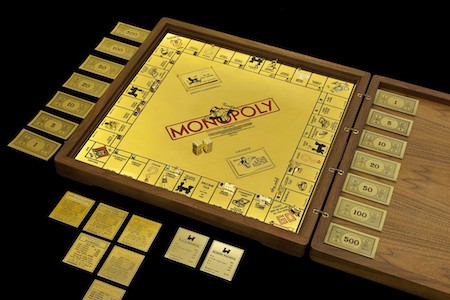
Sidney Mobell (pictured), the San Francisco jeweler known for turning everything from toilet seats to sardine cans into gem-studded art, died on Nov. 5. He was 96.
Mobell was born in 1926. At 10 years old, his mother had to travel to the Mayo Clinic for orthopedic surgery and couldn’t bring along her children. As a result, Mobell and his two siblings were sent to an orphanage in Denver—an experience he never forgot. (His book is called From an Orphanage to the Smithsonian.)
After serving in the Navy during World War II, Mobell got his first job in the jewelry business, as a traveling salesperson for Jacques Kreisler Manufacturing.
After moving to San Francisco, a friend called and offered to partner with him in a local jewelry store that had just gone bankrupt. And while business was OK, Mobell felt the need to set himself apart.
“I figured, if I’m going to be in business, I have to do something different than all the other jewelers,” he said in a 2016 Q&A session with the Museum of American Finance. “If I don’t do something different, I’m just going to be another store that’s existing.”
One of his first jeweled art creations was a gold replica Mickey Mouse watch. When San Francisco Chronicle writer Herb Caen mentioned it in his column, Mobell was swamped by publicity.
“I got a call from the Disney lawyers in Anaheim,” he said later, “I thought for sure they were going to sue me for copyright infringement, but they asked me to make one of the watches for Walt Disney’s brother Roy.”
From then on, he released a gem-studded object every year. (They generally took about a year to plan and create.) His imagination was sparked by everything from common household objects to hot items in the news. Among his works: a gold and gem-studded toilet, a working gumball machine, a cell phone, chess set, and—perhaps most famously—a $2 million Monopoly set, which in 1998 won the Guinness record for the world’s most expensive Monopoly game.

No item, it seemed, was too bizarre for Mobell to re-create in glitter—even a sardine can.
“I was in the supermarket one day with my wife, Ronni,” he told the Tampa Bay Times. “I picked up a can. I got home and opened it with that little key. The next day I took it in and gave it to my shop to make in 18k gold…. My wife thought I was crazy.”
The creations nabbed him global headlines and even a regular Christmas spot on the Tonight Show Starring Johnny Carson—which he noted once featured his toilet seat over the credits.
The items also drew celebrities and curiosity seekers to Mobell’s two stores—one located in the Fairmont Hotel, one on Post Street.
“People asked, ‘Do you ever sell these things?’ ” Mobell said on the Museum of American Finance panel. “We sold five [golden mousetraps] for $12,000 each.”
One buyer he later revealed was Joan Croc, whose husband, Ray, founded McDonald’s. She approached Mobell looking for a unique gift for her husband, who, she said, had “everything.”
“I said [she should] give it to him with a trophy,” he said on the panel. “I’m going to engrave the back of it, ‘Happy birthday, Ray. Thanks for catching me. Love, Joan.’ You know how fast it took for her to hand over $12,000?”
He even took customized requests, including one woman who asked him to make a jewelry out of her gallstones.
In 1996, he sold his store to another San Francisco jeweler, Shreve & Co. In the early 2000s, he donated 20 of his works to the Smithsonian Institution, which set up an exhibit, Everyday Fantasies: The Jeweled Art of Sidney Mobell.
Reviewing the collection, a Georgetown Voice writer was particularly entranced by the sardine can.
“It had elegant curves of amber light, sparkling showers of silver-blue scales, and a key so smooth and dazzling it could unlock a star,” said the review. “I could not believe I had never noticed the sardine’s beauty before.
“With the sardine can, as with his other creations, Mobell achieves something remarkable,” the writer said. “He forces us to see the extraordinary beauty present in what we consider trivial and mundane. Sidney Mobell is not an artist skilled at molding valuable foils and rocks. He is an artist skilled in peeling back the cardboard, plastic and prejudice of everyday life and showing us the hidden glitter that we had missed from the beginning.”
When Mobell’s death was announced on LinkedIn, among the commenters was Christopher Caen, son of Herb Caen, the columnist who helped make Mobell’s name.
“San Francisco is a little less colorful tonight,” Caen said.
Sidney Mobell was predeceased by a daughter, Marci, and his wife, Ronni. He is survived by son Grant, three grandchildren, and three great-grandchildren.
Top: Sidney Mobell at the Museum of American Finance’s Worth Its Weight exhibition in 2015 (photos by Alan Barnett Photography; courtesy of the Museum of American Finance)
- Subscribe to the JCK News Daily
- Subscribe to the JCK Special Report
- Follow JCK on Instagram: @jckmagazine
- Follow JCK on X: @jckmagazine
- Follow JCK on Facebook: @jckmagazine






